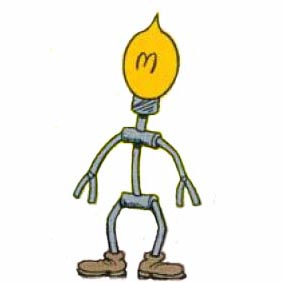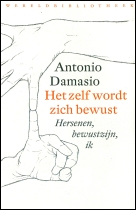Damasio and Spinoza Damasio gives with the book closer and new insight in the way the brain works. Where previous books referred explicitly to Spinoza, he speaks herein only lateral concerning him as 'my friend Spinoza'.
Damasio gives with the book closer and new insight in the way the brain works. Where previous books referred explicitly to Spinoza, he speaks herein only lateral concerning him as 'my friend Spinoza'.
In the 'Treatise concerning the improvement of the mind', written on young age, Spinoza writes about his intention to go and search for 'true knowledge'. To the core of what is important knowledge. To knowledge what he and everyone carry in himself and of which we approximately know what it implies, but not exact. It is his aim to increase this knowledge together with others.
The location in the brain for this inner knowledge, the spot from which comes permanently attempts to reach for the best inner standard (Treatise concerning the improvement of the mind 69/70, Dutch translation Verbeek, pg 62), is most probable the same as Damasio's spot where the homeostatic processes take place. Therefore near the old brain-tame. In Spinoza's time people spoke of the 'intuitive mind' and 'intuitive knowledge'. One could not see these by direct observation, but by using logic Spinoza gives already a picture and a close outline. Damasio fills in the picture with concrete observations. He enriches in therewith the SCIENTIFIC KNOWLEDGE.
Damasio and free will
In Damasio there is room for 'free will'. In an interview with Hendrik Spierink (NRC on 16/17 October 2010) Damasio sets out how he hands Victor Lammes 'Free will does not exist'. Damasio himself has changed his mind about the subject compared to 2003, when his books 'Looking for Spinoza' and "I feel therefore I am' appeared. In his new book, thinking has been given a clearer role.
Damasio: 'Victor Lamme called consciousness scornfully a 'chatter box'. Consciousness for him is it just an old man, who watches from a bench. This not Damasio point of view. In his view consciousness functions as conductor. Many experiments that are supposed to prove the enormous importance of the unconscious he speaks against by a simple: 'Do you really think that these experiments were successful with people who were in a coma (N.B. Damasio did much research with patients in coma, M.B.)'.
Spierink: ‘Just six years ago you said that consciousness plays only a minor role in human decisions. Biology some 90 percent. Now describe consciousness as a true leader, a conductor. What has changed?'
Damasio: 'Did I say really 90% at that time? Way too much. I probably drank wine. it is also absurd te give this a numerical expression. Anyway, I still insist that we be guided in many cases by rapid non-conscious processes. Otherwise life would be a mess! What is new in my work, is the insight that consciousness has a very important role by what I call 'slow thinking'. The modus of deliberation of the brain. This is precisely the foundation for the subsequent rapid, often unconscious, reactions. The thing is, that in our brains constantly a lot of ideas are connected by dispositions, unconscious linking of ideas. That is the essence of thinking: linking ideas. There is almost a constantly a huge unconscious process of connecting ideas going on.  Thanks to genetic dispositions that are often set with basic emotions and motivations as sex and hunger. These connections are made quickly. Most small animals never make a reaction, they have no time, they have no knowledge and they do not have the mental space to reflect. What happens in your mind without conscious planning you can compare what happens in a dream. Then the dispositions entirely go their own way. But in humans there is a second system due to consciousness. And that is much slower. In the consultation mode you remove yourself from the mostly automatic 'online mode' reactions to the here and now. In the off-line thinking in your head you create a large room with many performances in which you will practice and play opportunities. Such as planning one day and decide what you going to do with your money. You have to detach yourself from your environment. You go white, you are expressionless. It all has to do with an important evolutionary function: delaying a response.
Thanks to genetic dispositions that are often set with basic emotions and motivations as sex and hunger. These connections are made quickly. Most small animals never make a reaction, they have no time, they have no knowledge and they do not have the mental space to reflect. What happens in your mind without conscious planning you can compare what happens in a dream. Then the dispositions entirely go their own way. But in humans there is a second system due to consciousness. And that is much slower. In the consultation mode you remove yourself from the mostly automatic 'online mode' reactions to the here and now. In the off-line thinking in your head you create a large room with many performances in which you will practice and play opportunities. Such as planning one day and decide what you going to do with your money. You have to detach yourself from your environment. You go white, you are expressionless. It all has to do with an important evolutionary function: delaying a response.
Spinoza
Spinoza discusses the workings of the Will in Ethics part II, propositions 48 and 49. 48: ...Under ' Will ' I mean the ability to confirm or to deny ', not ' However 'the Desire' ....; 49, Encore: ' Will and Intellect are one and the same '. (N.B. This corresponds with texts by Dirck Volckertszoon Coornhert)
Antonio Damasio ‘Self comes to mind: Constructing the conscious brain’
Wereldbibliotheek, 2010
'Self comes to mind'
Damasio's 'Self comes to mind' is an innovative book. De neurologist wrote schreef ook 'Descartes' error - Emotion, reason and the human brain' (1994), 'The feeling of what happens - Body and emotions in the making of consciousness' (1999) en 'Looking for Spinoza - Joy, sorrow and the feeling brain' (2003). 'Self comes to mind' is quite technical because it contents much of Damasio's own research from his neurological clinic. Based on his research he identifies very specific brain areas and their functions. Areas and functions that are specific for human beings. The areas of Coornherts 'spark of the divine light'; the conscious thinking of the human. Based on his research Damasio puts that there is more 'free will' than he had supposed before (see right site).
Although the book is quite technical, it can be read very well by someone who is not a neuroscientist when one leaves the technical names. The book can be related to Spinoza's early work 'Treatise on the improvement of the mind', in which Spinoza describes how he will make a life-journey to dicover the world and on what he will aim his attention most (our own nature as a human and of Nature, the whole world, just as much as is necessary). Damasio gives insight from the most recent developments in neuroscience (2010) in the impact and interaction of different brainparts. Anno 2013 this continues in neuroscience in the attention for the flexibility in human(s): besides 'we are our brain' (D. Swaab) stands 'We become our brains'.
Summary of 'Self comes to mind'
One can't really say there is a center in the brain. Not this or that center is the boss. There is a constant interplay going on in which the whole body plays a role. And through the body the environment. Connections with electric pulses are quickly made and coordinated.
Allready simple animals, even plants, strive for 'survival' of itself and/or of the species and do have systems for this, generally homeostatic systems. The brain-tame plays the head role in the homeostase. The systems can react in interaction with experiences with the environment. These systems work the way that there is a homeostatic benchmark together with a system which in case of too big a deviation, it makes the body to develop counter feedbacks. In simple animals this works automatically . This automatic reactions develop from young by the interaction of these systems with the environment. Specific knowledge about the environment is fixed in the animal connected to the homeostatic systems. Response patterns of animals and people are similar, also in facial expressions. Certain facial expressions of animals look alike those which belong to human emotions. Emotions can be considered as a component of the automatic pilot of people. What has been joined to positive emotions, one tends to look for; what has been connected to negative emotions one tends to avoid. (This is also to be found in the work of Spinoza).
In the course of the evolution one can see in certain animals already a certain beginning of what has been developed in people to a larger scale and complexity. Human beings fix experiences in autobiographical images. Beside the automatic response to external pivots people develop a system for it on the basis of the autobiographical data, that distinguishes itself so much of emotions that Damasio have a separate word: feelings. The difference with emotions is that feelings don't have to lead directly to action like is the case at emotions. They have a slower-working effect.
The fact that people developed those, did open a number of possibilities:
1 it enables to imagine oneself in another person:
2. people can as a result, because the autobiographical memory has developed more than animals, plan ahead for a longer period and are able to have more plans in interaction with others.
If one awakes, there is (excluding exceptions) consciousness. Is there a spot where the consciousness is located? A spot which coincides with the feeling to be his/hers own `I'? To his own stupefaction Damasio finds such a spot: in the posteromedial cortices (PMC). For someone who is not a neuroscientist such a denomination says little, but of importance is to understand where the spot has been located with respect to other brainfunctions. The brain exists of 1. the old brainparts, the senior is the brain-tame, therefore the spot where homeostatic processes have been localised and 2. the newer parts, the lord cortex, with to the front the prefrontal lobes.
In this specific area the thinking and planning is localised. Here many experiences are stored. In between are localised a number of intermediating functions, which form a in-between-station to the rest of the body. The PMC are localised in the middle of the passage areas of the brain near to the areas of older date, therefore nearer to the brain-tame then to the prefrontal cortex (the planning area).

